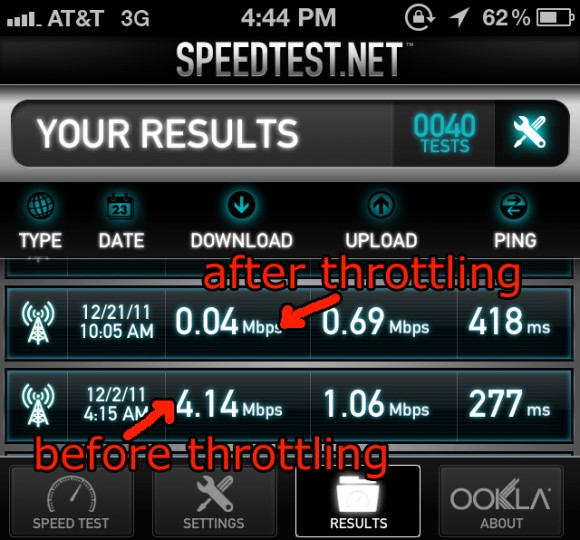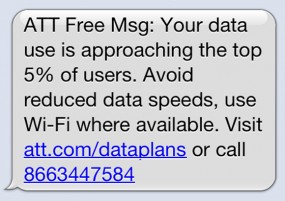Eight things you can do about getting your data throttled by AT&T

Let me start by saying that right now, AT&T has customers in a sucky place, with only one decent option to fight back against their data throttling initiative. But first, a recap:
In the Fall of 2011, AT&T announced that it was going to start throttling its top mobile data users, hinting that these were the 100GB/mo torrenting bandits that were responsible for the sluggish data and dropped calls plaguing iPhone users since the 3G model came out. A few months later, the throttling began — but to the horror of longtime customers who were rewarded for their loyalty by being able to keep their now-discontinued unlimited plans, AT&T wasn’t just targeting users with unbelievably high consumption, but was cutting off anyone that moved past a mark generally around 2.2GB, saying they were in the top 5% of data users (read my writeup about this and the reader comments).
With throttled speeds at an unusable 1/100 of normal, it appears that AT&T is effectively trying to rid itself of the remaining unlimited data plans — these limitations are only only placed on unlimited accounts, not on the tiered plans. Their method is devilishly clever and frustrating — they are still offering as much data as you can ingest, they’ve just never said they’d deliver it at high speeds. Naturally, users are outraged and want to fight back.
There aren’t many options, and those that exist have some hangups. But for those willing to duke it out, here’s a rundown of options that you can do.
 – Manage your data
– Manage your data
This is what AT&T is suggesting — for you to handle the burden instead of them. Decide if you REALLY need to watch that episode of “30 Rock” while on the treadmill (my vote: yes, you do). Don’t stream music on Pandora or Spotify when you’re not in your living room with your stereo. And, blech, connect to wifi whenever available — nevermind the fact that it drains your battery faster and that you’re now paying double for data that was supposed to be unlimited.
– Switch to a tiered plan
While AT&T suggests managing your data, what they really want is for their unlimited customers to move onto a tiered plan. And to get you to do so, they’re stopping your data at a lower point (~2GB) than what you’d get for paying the same amount ($30) as their lowest tier (3GB). Using that breakdown, it only makes sense to switch — you get more data for the same amount of money.
However, the part that comes into play is that the tiered plan will cost you an extra $10 for each GB of data you go over your allotment. So if you send and receive a lot of videos of your new baby learning to walk to all your friends and family, there’s a good chance you’ll be sending AT&T a lot more money than you would have on the unlimited plan that you initially signed up for.
– Sue in small claims
This right now looks to be the best realistic option, but it’s not without time or energy.
On February 24, Matt Spaccarelli took AT&T to small claims court over his throttled data — and won. His award was a non-life-changing $850, the amount that difference between his throttled unlimited data and what he’d have had to pay for a tiered plan. If you want to pursue the same approach, the process of going to small claims isn’t hard, but it’s best to do your homework and come in prepared — you’ll have to explain your case, the livelihood that you lost because of the throttling, and how this wouldn’t have happened without that. But the precedent has been set, and if enough users follow suit, it could put pressure on AT&T to relax their throttling. Spaccarelli (twitter) has offered to make his case materials public so that others can use them in their fight too; in the meantime Attorney Bradley Sniderman has a writeup on a smart approach to small claims to fight for your data.
 – Use a data compression app
– Use a data compression app
After last month’s throttling, I started experimenting with an app called Onavo — it’s enables a basic form of data compression/cacheing on the iPhone that can save a few hundred megabytes over the course of a month. This might be the difference it takes to get you to the next billing period without any slowdowns. I haven’t noticed any major adverse affects with this app running, but there’s a chance it can dig into a bit of your battery life and some possible map caching funkiness.
– Switch to Sprint
Of the three US carriers that offer the iPhone, Sprint is the only one that continues to offer an unlimited data plan. Reports from users vary but tend to indicate the service is slower than AT&T/Verizon. Those who have switched to it have expressed satisfaction at having as much data breathing room as they wish, even given the slower speeds.
But there are two points to consider: Sprint has a smaller network than the other two iPhone carriers, so make sure to thoroughly check that you get a signal in all the places you need it to work (this goes with any carrier — I’ve had an AT&T phone that cut out once I drove onto my old street in LA on AT&T, and another on Helio/Sprint that didn’t work inside my old office in Berkeley). And, there’s always the possibility that Sprint is only offering “unlimited data” as a way to grab as many customers from the other two companies, until they reach a point when they determine that the balance of new-customers-to-data-expenses has been maximized and they then start charging for it just like AT&T and Verizon do.
– Suck it up (“outside week”)
The easiest way to handle things. Just use your phone as normal, watch your netflix and youtube videos. Then, when you hit the mystery data point (2.2GB? 1.6? AT&T is doing a really good job of keeping this information private), put down your phone, go outside with your wife, kids or pals, and enjoy a week of being disconnected. Obviously, this doesn’t work well if you rely on your phone for crucial purposes — like the throttled paramedic who uses his for emergency response.
– Try to push the 5% bar higher
The mysterious “top 5%” that AT&T is administering to users puts us into sort of game theory scenario — by having us manage our data, the level of data use before getting throttled will continue to decline each month. But if all the users were able to join forces and max out their data use — continuing to stream as much data once the throttling begins (which might entail a tethering solution, bringing up an entirely separate AT&T issue), the level of “top data” theoretically should go higher. There’s no guarantee that this will work, however, as there’s no guarantee that AT&T’s “top 5%” is based on any computational figures but rather a preset limit that has been dubbed “top 5%.”
– Petition and protest
Let AT&T know you’re angry by joining and participating in facebook groups like “Fight AT&T ‘Unlimited’ Data Throttling” and Change.org’s AT&T Data Throttle Petition. Just remember, the AT&T EULA that you signed prohibits class action law suits, so don’t expect much to come from these angry groups of users.
Finally, I encourage everyone to keep track of their iPhone data and compare it to the data that AT&T’s website is reporting — there are indications that these numbers don’t match up.
